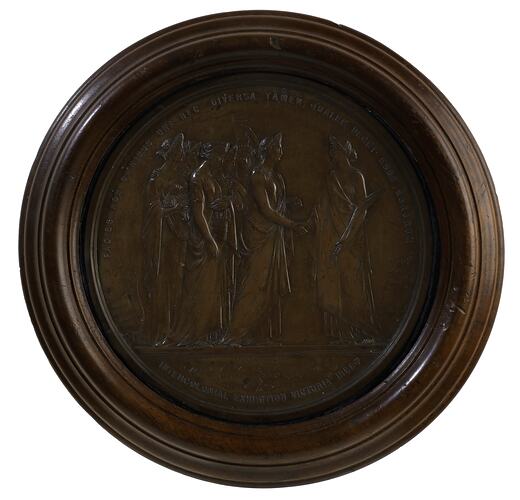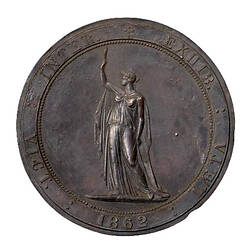Summary
Australia Victoria Melbourne
Commissioners Medal - Melbourne 1866 Intercolonial Exhibition of Australasia
Artist: Charles Summers
Manufacturer: W. Calvert
Awarded to: Rev. John Ignatius Bleasdale
648 medallions were produced to be awarded to exhibits of excellence at the Intercolonial Exhibition and an additional 50 for special merit. This medal is in a circular cedar frame (missing the original convex glass cover). The recepient, Rev. John Ignatius Bleasdale D.D., wrote a history of Victorian wine, was chief wine judge at the Exhibition and was Executive Commissioner for Juries. He also sat on the royal commission that planned the exhibition, and entered a case of colonial gems, both rough and polished, which he had collected (Official Record, p.11). In addition, he submitted two pen and ink drawings: 'Ecco Homo!' by Guido Reni and 'The Crucifixion' by an 'Italian' artist (p.112) and a painting of the crucifixion on three folding panels (p.115). His abilities in mineralogy were recognized in Australian and international circles. Bleasdale was born in England and was ordained at the age of 22. He moved to Australia in 1851 and was associated for many years with St Francis Church, Melbourne. He was deeply interested in science and was an outstanding figure in Catholic scientific circles. He was an active member of many scientific societies and at one time was a trustee of the Melbourne Public Library, Museum and National Gallery. The Intercolonial Exhibition of Australasia was held on the site of the Public Library, in new wings that eventually became the site of the Industrial and Technology Museum in 1870, a forerunner to the National Museum.
Physical Description
Inside a circular cedar frame (with convex glass cover missing) the bronze medal features on the right, the personification of Victoria, standing facing left and holding palm in left hand while receiving her "six sisters" who each bring a contribution; Behind Victoria is a Lion's head perhaps representing one of the lions that flanked the Museum (where the Exhibition was held). Behind the 'six sisters' an ancient ship's prow. Around above, hand engraved, the Latin FACIES NON OMNIBUS UNA NEC DIVERSA TAMEN QUALEM DECET ESSE SORORUM [translates as: "They all look different and yet alike : as sisters would"]. The exergue legend reads in four lines (the first three engraved) PRESENTED TO / Dr. I.I. Bleasdale D.D. / INTERCOLONIAL EXHIBITION VICTORIA 1866-7.
Obverse Description
On the right, the personification of Victoria, standing facing left and holding palm in left hand while receiving her "six sisters" who each bring a contribution; Behind Victoria is a Lion's head perhaps representing one of the lions that flanked the Museum (where the Exhibition was held). Behind the 'six sisters' an ancient ship's prow. Around above, hand engraved, the Latin FACIES NON OMNIBUS UNA NEC DIVERSA TAMEN QUALEM DECET ESSE SORORUM [translates as: "They all look different and yet alike : as sisters would"]. This medal is in a circular wooden frame missing the convex glass cover. In exergue in four lines (the first three engraved) PRESENTED TO / Dr. J.I. Bleasdale D.D. / COMMISSIONER / INTERCOLONIAL EXHIBITION VICTORIA 1866-7. In tiny letters on left, C. SUMMERS, SCULP; in tiny letters on right, W. CALVERT, FECIT
Reverse Description
Plain
Edge Description
Plain
Significance
The idea of an intercolonial exhibition for Melbourne was first suggested by the Hon. Samuel Henry Bindon, MLA for Castlemaine. Bindon reminded parliament of the success of Great Exhibition held in England in 1851. Parliament approved the proposal, commissioners were appointed, Australian and New Zealand governments notified and preliminary minor exhibitions in regional Victoria initiated as a lead-up to the main exhibition. It was decided that the exhibition building erected in William Street for the 1854 Melbourne Exhibition was unsuited to the purpose. Instead, it was decided to use the site of the Public Library and construct further spaces that could be later used to house a museum, including a Great Hall, Northern and Southern Wings and an Iron Annex accessed via Russell Street. The Exhibition led to the opening of the Industrial and Technology Museum in 1870, a forerunner to the National Museum of Victoria.
The Exhibition covered 56,240 ft. The majority of the 2,956 exhibitors were Victorian, but the other Australian states also contributed significantly; displays were also mounted by exhibitors from New Zealand, New Caledonia, Netherlands-India and Mauritius.
The opening of the Exhibition on 24 October 1866 was spectacular. A 'golden pyramid' glittered in the great Hall, banners waved, trophies and crystal ornaments sparkled. The Governor and his family arrived to a rousing rendition of the national anthem and the Hallelujah Chorus, witnessed by a large audience of season ticket holders and 120 military volunteers in a guard of honour. As well as a considerable assortment of male dignitaries there 'was also present a large and brilliant assemblage of ladies'. It was a 'scene which we venture few colonies have ever beheld', wrote one commemtator. Speeches were delivered, cheers rang out and the exhibition was declared open.
The exhibits were assesed by 39 juries totalling 224 men. 648 medallions were made as awards for exhibits of excellence. A council of jury chairmen also decided on the award of 50 'special merit' medallions. The commission for the medallion was awarded to Charles Summers. Summers created a large format (215mm) medallion in neo-classical form. Australia lacked the technology to produce a medal of this size, so Summers used an electroforming technique that deposited a thin layer of copper onto the artwork. The copper was lifted off and finished; the original artwork could then be used again. The end result was thin and fragile, but appeared like a fine medallion. Summers was the first Australian medallist to challenge the preference for British-struck medals, although this technique was never repeated in Australia. -Sharples, John P. 1990. Medals as art: Australia and the Meszaros tradition. -D. Tout-Smith 17/9/2003.
Awards were distributed to exhibitors on 15 February 1867. The Exhibition closed on 23 February 1867. A total of 268,634 people attended. 9,634 pounds gross were taken in admission fees. -Intercolonial Exhibition of Australasia, Melbourne, 1866-67: Official Record. -D. Tout-Smith 8/12/2003.
The recepient of this medal, Rev. John Ignatius Bleasdale D.D., wrote a history of Victorian wine and was chief wine judge at the Intercolonial Exhibition, Melbourne, 1867. He also sat on the royal commission that planned the exhibition and entered a case of colonial gems, both rough and polished, which he had collected (Official Record, p.11). His abilities in mineralogy were recognized in Australian and international circles. Bleasdale was born in England and was ordained at the age of 22. He moved to Australia in 1851 and was associated for many years with St Francis Church, Melbourne. He was deeply interested in science and was an outstanding figure in Catholic scientific circles. He was an active member of many scientific societies and at one time was a trustee of the Melbourne Public Library, Museum and National Gallery. -Australian Dictionary of Biography. -D. Tout-Smith 5/12/2003.
The medal was designed by Charles Summers and manufactured by William Calvert, a Melbourne-based lectrotypist and ornamental printer. -D. Tout-Smith 6/1/2004.
More Information
-
Collecting Areas
-
Acquisition Information
Transfer from National Gallery of Victoria (NGV), 15 Mar 1976
-
Date Issued
1866-1867 AD
-
Issued By
-
Mint
William Calvert, Melbourne, Greater Melbourne, Victoria, Australia, 1866
-
Artist
Charles Summers, Melbourne, Greater Melbourne, Victoria, Australia, 1866
-
Awarded To
Reverend John I. Bleasdale, 1867
Dr Bleasdale wrote a history of Victorian wine and was chief wine judge at the exhibition. -
Inscriptions
Around above: FACIES NON OMNIBUS UNA NEC DIVERSA TAMEN QUALEM DECET ESSE SORORUM [translates as: "They all look different and yet alike : as sisters would"]. In exergue in four lines (the first three engraved) PRESENTED TO / Dr. I.I. Bleasdale D.D. / COMMISSIONER / INTERCOLONIAL EXHIBITION VICTORIA 1866-7 in tiny letters on left, C. SUMMERS, SCULP in tiny letters on right, W. CALVERT, FECIT
-
Series
-
Material
Bronze
-
Classification
-
Category
-
Discipline
-
Type of item
-
Dimensions
285 mm (Outside Diameter)
-
Shape
Round
-
References
A further publication titled Intercolonial Exhibition, 1866. Official Catalogue, is available at Museum Victoria library.
[Book] 1867. Intercolonial Exhibition of Australasia, Melbourne, 1866-67: Official Record.
-
Keywords



